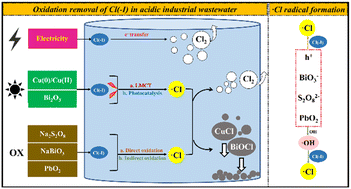Removal of Cl(−I) from acidic industrial wastewater through oxidation: a review on methods and mechanisms
Abstract
An abundance of acidic wastewater containing high concentrations of Cl(−I) is produced annually in industries. The traditional precipitation, ion exchange and physical separation methods for Cl(−I) removal possess the major limitation of low efficiency, making it necessary to develop new approaches with high efficiency. Recently, the technology of advanced oxidation process (AOPs) and ligand-to-metal charge transfer process (LMCT) has attracted considerable attention for the oxidation removal of Cl(−I), where the various intermediate active species with extremely high oxidability exhibit the ability to oxidize Cl(−I). In this article, the efficiency, mechanisms, advantages, limitations, developmental trends and potential improvements of the electrolysis, UV-induced and strong-oxidant-dominated oxidation approaches for Cl(−I) removal are reviewed in detail. The oxidation approaches exhibit the common advantage of high efficiency. However, the potential secondary pollution of Cl2 gas and the high requirement for wastewater quality limit the actual application. Before the electrolysis and UV-induced oxidation methods can be applied, the energy consumption must be further reduced. Additionally, the slow release and stability of the Na2S2O8, NaBiO3 and PbO2 agents should be further studied in the strong-oxidant-dominated oxidation approaches. This study provides the effective removal of Cl(−I) from acidic industrial wastewater with the theoretical foundation and technical support.

- This article is part of the themed collection: Environmental Science: Water Research & Technology Recent Review Articles


 Please wait while we load your content...
Please wait while we load your content...